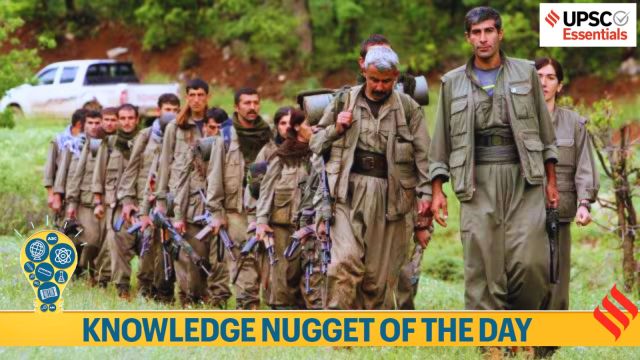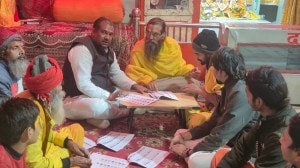
Why in the news?
After 40 years, the Kurdish group Kurdistan Workers’ Party (PKK) has announced disbandment and an end to Turkey insurgency. The announcement came on Monday after a congress was held in northern Iraq. A senior PKK official confirmed to Reuters that fighting would stop “immediately”. However, they added that handing over weapons would depend on how the Turkish government handles issues like Kurdish rights and the future of PKK members.
Key Takeaways :
1. The Kurdistan Workers’ Party (PKK) is a Kurdish group that began an armed conflict with the Turkish government in 1984. It first aimed to form a separate Kurdish state, but later started asking for more rights and autonomy for Kurds in Turkey. The group is based in northern Iraq and is considered a terrorist group by Turkey, the United States, and the European Union.
2. The PKK’s jailed leader, Abdullah Ocalan, will guide the process, according to the statement. Ocalan has been in prison since 1999. He had called for the group to dissolve earlier this year.
3. It is unclear whether Turkey accepts Ocalan’s continued role in the peace process. The government has not shared details on how disarmament will take place.
Who are Kurds? Where are they mainly located?
1. Kurds are an ethnic group that make up around 20% of Turkey’s 86 million people. They are centred in Iran, Iraq, Syria, and Turkey. They speak several dialects of Kurdish, a language that is not linked to Turkish or Arabic. The majority are Sunni Muslims.
Story continues below this ad
 Main Kurdish areas in Middle East.
Main Kurdish areas in Middle East.
2. Turkey has the largest Kurdish population (estimated at 43 per cent), followed by Iran (31 per cent), Iraq (18 per cent), Syria (6 per cent) and the former Soviet Union which includes Armenia and Azerbaijan (estimated to be 2 per cent).
3. Notably, Following World War I, world powers promised the Kurds their own homeland, but this promise was never fulfilled. Kurdish rebellions erupted in numerous nations in subsequent generations, and Kurds’ language and culture were suppressed by the state.
What is the history of the Kurdish question?
1. Following the First World War, the declaration of the Fourteen Points by the former President of the United States Woodrow Wilson accorded non-Turkish minorities the right to “autonomous development” (Point Number 12).
2. Further as argued, the Treaty of Sèvres (1920) explicitly provided for “local autonomy for the predominantly Kurdish areas” (Article 62), and even promulgated the possibility that “the Kurdish peoples” might be granted “independence from Turkey” (Article 64).
Story continues below this ad
3. However, the Treaty of Lausanne (1923) recognised the modern Republic of Turkey without any special provisions for Turkish Kurds. Turkey since then didn’t accept any provision where Kurds can demand autonomy.
4. Turkey does not allow any census based on ethnicity. However, unofficial records suggest the highest concentration of Kurds live in Turkey compared to even Iraq, which is home for the Kurdish majority in popular imagination.
5. In Turkey, one out of every fifth is a Kurd. When the Kurdish question became a qualifying condition for the membership of the European Union (EU), the Turkish government on many occasions echoed the voice to resolve the matter. For Turkey, “the road to the EU goes through Diyarbakır”. Diyarbakır, the largest Kurdish populated area in Turkey, has been a flashpoint of conflict between ethnic Kurdish groups and Turkey.
BEYOND THE NUGGET: Baloch and their demand for Balochistan
1. The 909-km Iran-Pakistan border, known as the Goldsmith Line, stretches from a tripoint with Afghanistan to the northern Arabian Sea. Roughly 9 million ethnic Baloch live on either side of the line, in the Pakistani province of Balochistan, and the Iranian province of Sistan and Baluchestan. Another 500,000 live in the neighbouring areas of Afghanistan in the north.
Story continues below this ad
2. The Baloch share cultural, ethnic, linguistic, and religious links that transcend modern borders. They also nurse deeply rooted grievances against both the Pakistani and Iranian states.
 Map showing Baloch areas
Map showing Baloch areas
3. In Pakistan, the Baloch are an ethnic minority physically and politically distant from the Punjabi-dominated regime; in Iran, in addition to being an ethnic minority, the majority-Sunni Baloch are also a religious minority who have been persecuted by the state.
4. The Baloch homeland is rich in natural resources but impoverished. In Iran, 80% of the Baloch population lives under the poverty line. In Pakistan, massive investments in projects such as China’s Belt and Road initiative have not improved their lives.
5. Baloch nationalism traces its roots to the early decades of the 20th century, when new international borders came to be drawn in the region. Their marginalisation in both countries in subsequent years fuelled several separatist movements for a “Greater Balochistan” nation state.
Post Read Questions
(1) Consider the following pairs: (UPSC CSE 2016)
Story continues below this ad
|
Community sometimes mentioned in the news |
In the affairs of |
| 1. |
Kurd |
Bangladesh |
| 2. |
Madhesi |
Nepal |
| 3. |
Rohingya |
Myanmar |
Which of the pairs given above is/are correctly matched?
(a) 1 and 2 only
(b) 2 only
(c) 2 and 3 only
(d) 3 only
(2) The Kurds are an ethnic group concentrated in:
1. Iraq
2. Iran
3. Afghanistan
4. Turkey
5. Egypt
Select the correct answer using the codes given below:
(a) 1 and 2 only
(b) 2, 3 and 5 only
(c) 1, 2, 3, 4 and 5
(d) 1, 2 and 4 only
ALSO READ: Conflicts in West Asia: Kurds and their struggle with statelessness
Subscribe to our UPSC newsletter. Stay updated with the latest UPSC articles by joining our Telegram channel – Indian Express UPSC Hub, and follow us on Instagram and X.
🚨 Click Here to read the UPSC Essentials magazine for April 2025. Share your views and suggestions in the comment box or at Manas Srivastava 🚨



 Main Kurdish areas in Middle East.
Main Kurdish areas in Middle East. Map showing Baloch areas
Map showing Baloch areas






























